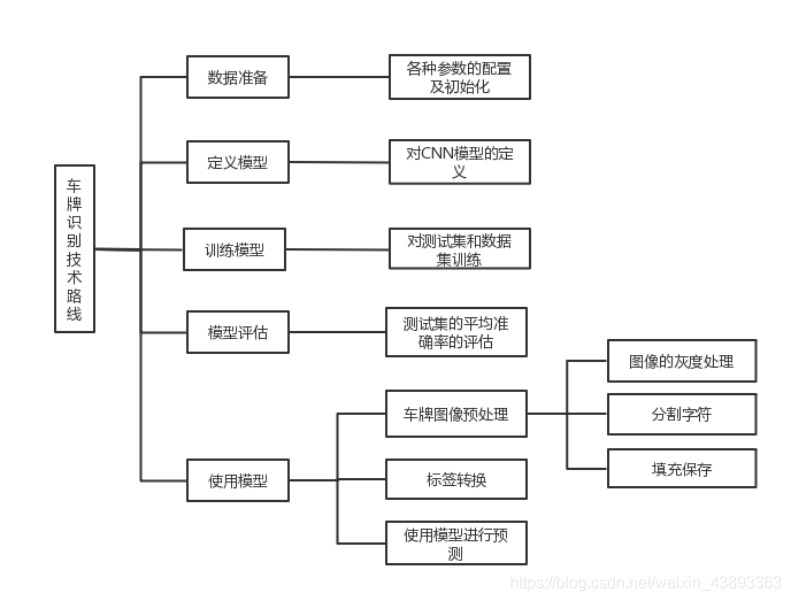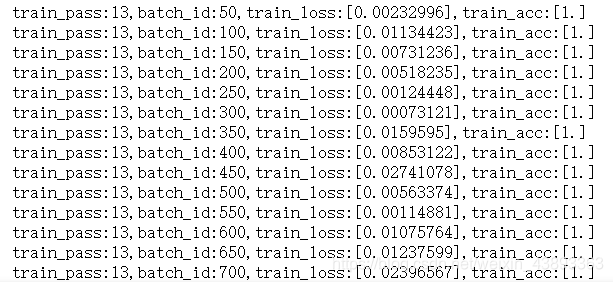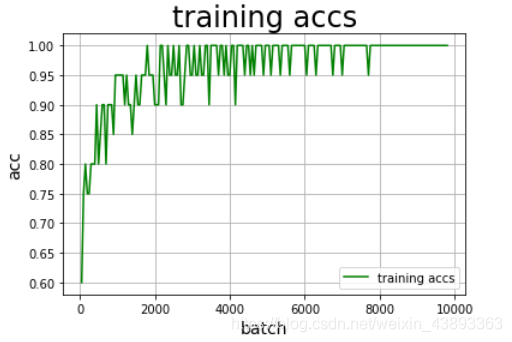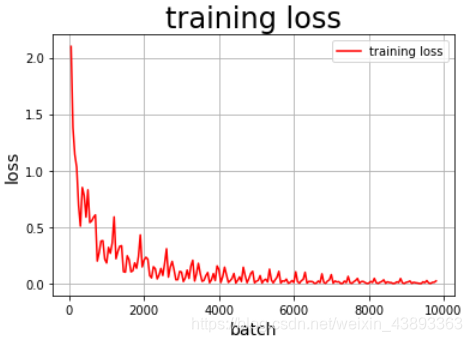1. 数据集描述
本数据集图片数约3.2万张,划分为65个部分。分别包含车牌中0到9(10个数字),A到Z(24个英文字母),以及31个省简称的图片数据。其中,图片分辨率为20*20的灰度图像。数据集中的10%作为测试集,90%作为训练集。
2. 技术路线
采用计算机视觉技术CNN实现车牌识别的流程主要包括数据准备,定义模型,训练模型,模型评估和使用模型5个步骤。路线图如下图1所示。
在数据准备部分,完成了各种参数的配置及初始化。
在定义模型部分,完成了对CNN模型的定义。
在训练模型部分,完成了对测试集和数据集训练,这里我取数据集中的10%作为测试集,90%作为训练集。
在模型评估部分,完成了对测试集的平均准确率进行评估。
在使用模型部分,完成了包括对车牌图像进行预处理,对标签进行转换及使用模型进行预测,其中对车牌图像进行预处理包括对图像进行灰度处理、分割出车牌中的每一个字符,填充后保存。

3. 模型结构
模型采用CNN网络结构,包含3个卷积层、2个池化层、多维输入一维化和2个线性变换。具体结构如图2所示。

4 .训练集上的表现
训练集上迭代了14次,记录每次训练的精度和损失并输出显示,最后绘制训练的精度和损失曲线。随着迭代次数的增加,训练精度来回波动并趋于1稳定,训练损失来回波动并趋于0。



5 .测试集上的表现
训练完成后,在测试集中进行测试,输出损失和精度的平均值。可以看到平均损失趋近于0高于训练损失1~2个数量级,平均精度趋近于1。测试结果如图6所示。

6. 主要问题解决过程
读取中文路径的cv2.imdecode()函数,发现还是报错,研究发现cv2.imdecode()函数里面有一个处理图像的参数,跟原来用cv2.imread()后又使用cv2.cvtColor()函数来处理图像冲突了,将cv2.cvtColor()函数问题就解决了。
注:我将读取压缩包代码删除,将数据集直接解压读取
7.运行结果

8.代码
#导入需要的包
import os #导入标准库os
import random #random() 方法返回随机生成的一个实数,它在[0,1)范围内
import json #编码和解码 JSON 对象
import cv2 #图片操作
import numpy as np #矩阵操作
from PIL import Image #图片处理模块
import paddle #百度深度学习平台PaddlePaddle框架
import paddle.fluid as fluid#做图像分类工作
from paddle.fluid.dygraph import Linear,Conv2D,Pool2D # Linear线性变换层 Conv2D卷积二维层 Pool2D返回池化结果
import matplotlib.pyplot as plt #绘图
1、数据准备
'''
参数配置
'''
train_parameters = {
"input_size": [1, 20, 20], #输入图片的shape
"class_dim": -1, #分类数
"target_path":"./dataset", #要解压的路径
"train_list_path": "./work/train_data.txt", #train_data.txt路径
"eval_list_path": "./work/val_data.txt", #eval_data.txt路径
"label_dict":{}, #标签字典
"readme_path": "./work/readme.json", #readme.json路径
"num_epochs":14, #训练轮数
"train_batch_size":20, #批次的大小
"learning_strategy": { #优化函数相关的配置
"lr": 0.01 #超参数学习率
}
}
def get_data_list(target_path,train_list_path,eval_list_path):
'''
生成数据列表
'''
#存放所有类别的信息
class_detail = []
#获取所有类别保存的文件夹名称
data_list_path=target_path
class_dirs = os.listdir(data_list_path)
#print(class_dirs)
if '__MACOSX' in class_dirs:
class_dirs.remove('__MACOSX')
# #总的图像数量
all_class_images = 0
# #存放类别标签
class_label=0
# #存放类别数目
class_dim = 0
#存储要写进eval.txt和train.txt中的内容
trainer_list=[]
eval_list=[]
#读取每个类别
for class_dir in class_dirs:
if class_dir != ".DS_Store":
class_dim += 1
#每个类别的信息
class_detail_list = {}
eval_sum = 0
trainer_sum = 0
#统计每个类别有多少张图片
class_sum = 0
#获取类别路径
path = os.path.join(data_list_path,class_dir).replace('\\','/')
#print(path)
# 获取所有图片
img_paths = os.listdir(path)
for img_path in img_paths: # 遍历文件夹下的每个图片
if img_path =='.DS_Store':
continue
name_path = os.path.join(path,img_path).replace('\\','/') # 每张图片的路径
if class_sum % 10 == 0: # 每10张图片取一个做验证数据
eval_sum += 1 # eval_sum为测试数据的数目
eval_list.append(name_path + "\t%d" % class_label + "\n")
else:
trainer_sum += 1
trainer_list.append(name_path + "\t%d" % class_label + "\n")#trainer_sum测试数据的数目
class_sum += 1 #每类图片的数目
all_class_images += 1 #所有类图片的数目
# 说明的json文件的class_detail数据
class_detail_list['class_name'] = class_dir #类别名称
class_detail_list['class_label'] = class_label #类别标签
class_detail_list['class_eval_images'] = eval_sum #该类数据的测试集数目
class_detail_list['class_trainer_images'] = trainer_sum #该类数据的训练集数目
class_detail.append(class_detail_list)
#初始化标签列表
train_parameters['label_dict'][str(class_label)] = class_dir
class_label += 1
#初始化分类数
train_parameters['class_dim'] = class_dim
print(train_parameters)
#乱序
random.shuffle(eval_list)
#文件的写操作
with open(eval_list_path, 'a') as f:
for eval_image in eval_list:
f.write(eval_image)
#乱序
random.shuffle(trainer_list)
with open(train_list_path, 'a') as f2:
for train_image in trainer_list:
f2.write(train_image)
# 说明的json文件信息
readjson = {}
readjson['all_class_name'] = data_list_path #文件父目录
readjson['all_class_images'] = all_class_images
readjson['class_detail'] = class_detail
jsons = json.dumps(readjson, sort_keys=True, indent=4, separators=(',', ': '))
with open(train_parameters['readme_path'],'w') as f:
f.write(jsons)
print ('生成数据列表完成!')
#生成数据列表
#get_data_list(target_path,train_list_path,eval_list_path)
def data_reader(file_list):
'''
自定义读图片函数
'''
def reader():
with open(file_list, 'r') as f:
lines = [line.strip() for line in f]
for line in lines:
img_path, lab = line.strip().split('\t') #切割字符串
img =cv2.imdecode(np.fromfile(img_path, dtype=np.uint8),0) #imdecode解决读中文路径问题,参数0转换为灰度图像
img = np.array(img).astype('float32') #变化数组类型
img = img/255.0 #对图像进行归一化,范围为[0, 1]
yield img, int(lab)
return reader
'''
参数初始化
'''
target_path=train_parameters['target_path']
train_list_path=train_parameters['train_list_path']
eval_list_path=train_parameters['eval_list_path']
batch_size=train_parameters['train_batch_size']
#每次生成数据列表前,首先清空train.txt和eval.txt;从文件开头开始偏移,截断之后偏移后面的所有字符被删除
with open(train_list_path, 'w') as f:
f.seek(0)
f.truncate()
with open(eval_list_path, 'w') as f:
f.seek(0)
f.truncate()
#生成数据列表
get_data_list(target_path,train_list_path,eval_list_path)
'''
构造数据提供器返回的reader将输入reader的数据打包成指定的batch_size大小的批处理数据
paddle.fluid.io.batch(读取数据的数据reader,
批尺寸 batch_size,
若设置为True,则当最后一个batch不等于batch_size时,丢弃最后一个batch;若设置为False,则不会。默认值为False)
'''
train_reader = paddle.batch(data_reader(train_list_path),
batch_size=batch_size,
drop_last=True)
eval_reader = paddle.batch(data_reader(eval_list_path),
batch_size=batch_size,
drop_last=True)
Batch=0
Batchs=[]
all_train_accs=[]
def draw_train_acc(Batchs, train_accs):
title="training accs"
plt.title(title, fontsize=24)
plt.xlabel("batch", fontsize=14)
plt.ylabel("acc", fontsize=14)
plt.plot(Batchs, train_accs, color='green', label='training accs')#将y对x绘制为线条和/或标记
plt.legend() #给图像加上图例
plt.grid() # 生成网格
plt.show()
all_train_loss=[]
def draw_train_loss(Batchs, train_loss):
title="training loss"
plt.title(title, fontsize=24)
plt.xlabel("batch", fontsize=14)
plt.ylabel("loss", fontsize=14)
plt.plot(Batchs, train_loss, color='red', label='training loss')
plt.legend()
plt.grid()
plt.show()
2、定义模型
#定义CNN网络
class MyCNN(fluid.dygraph.Layer):
def __init__(self):
super(MyCNN, self).__init__()
self.c1 = Conv2D(1, 6, 5, 1) #批次的大小,卷积核个数,卷积核大小(5*5)
self.s2 = Pool2D(pool_size=2, pool_type='max', pool_stride=1) #池化核的大小;池化类型;池化层的步长
self.c3 = Conv2D(6, 16, 5, 1)
self.s4 = Pool2D(pool_size=2, pool_type='max', pool_stride=1)
self.c5 = Conv2D(16, 120, 10, 1)
self.f6 = Linear(120, 84, act='relu') #线性变换层输入单元的数目;线性变换层输出单元的数目; 激活函数
self.f7 = Linear(84, 65, act='softmax')
def forward(self, input):
#print("input shape : " + str(input.shape)) #[10, 1, 20, 20] Conv2D(1, 6, 5, 1) f=5*5
x = self.c1(input)
#print("C1 : " + str(x.shape)) #[10, 6, 16, 16] 16=20-5+1 Pool2D(pool_size=2, pool_type='max', pool_stride=1)
x = self.s2(x)
#print("S2 : " + str(x.shape)) #[10, 6, 15, 15] 15=16-2+ Conv2D(6, 16, 5, 1)
x = self.c3(x)
#print("C3 : " + str(x.shape)) #[10, 16, 11, 11] 11=15-5+1 Pool2D(pool_size=2, pool_type='max', pool_stride=1)
x = self.s4(x)
#print("S4 : " + str(x.shape)) #[10, 16, 10, 10] 10=11-2+1 Conv2D(16, 120, 10, 1)
x = self.c5(x)
#print("C5 : " + str(x.shape)) #[10, 120, 1, 1] 1=10-10+1
x = fluid.layers.reshape(x, shape=[-1, 120])
#print(x.shape) #[10, 120] Linear(120, 84, act='relu')
x = self.f6(x)
#print("C6 : " + str(x.shape)) #[10, 84] Linear(84, 65, act='softmax')
y = self.f7(x)
#print("C7 : " + str(y.shape)) #[10, 65]
return y
3、训练模型
with fluid.dygraph.guard():
model=MyCNN() #模型实例化
model.train() #训练模式
opt=fluid.optimizer.SGDOptimizer(learning_rate=train_parameters['learning_strategy']['lr'], parameter_list=model.parameters())#优化器选用SGD随机梯度下降,学习率为0.001.
epochs_num=train_parameters['num_epochs'] #迭代次数
for pass_num in range(epochs_num):
for batch_id,data in enumerate(train_reader()):
images=np.array([x[0].reshape(1,20,20) for x in data],np.float32)
labels = np.array([x[1] for x in data]).astype('int64') #转换数据类型
labels = labels[:, np.newaxis]
image=fluid.dygraph.to_variable(images) #创建一个 Variable 类型的对象
label=fluid.dygraph.to_variable(labels)
predict=model(image) #数据传入model
loss=fluid.layers.cross_entropy(predict,label)
avg_loss=fluid.layers.mean(loss)#获取loss值
acc=fluid.layers.accuracy(predict,label)#计算精度
if batch_id!=0 and batch_id%50==0:
Batch = Batch+50
Batchs.append(Batch)
all_train_loss.append(avg_loss.numpy()[0])
all_train_accs.append(acc.numpy()[0])
print("train_pass:{},batch_id:{},train_loss:{},train_acc:{}".format(pass_num,batch_id,avg_loss.numpy(),acc.numpy()))
avg_loss.backward()
opt.minimize(avg_loss) #优化器对象的minimize方法对参数进行更新
model.clear_gradients() #model.clear_gradients()来重置梯度
fluid.save_dygraph(model.state_dict(),'MyCNN')#保存模型
draw_train_acc(Batchs,all_train_accs) #训练集精度
draw_train_loss(Batchs,all_train_loss) #训练集上的损失
4、模型评估
#模型评估
with fluid.dygraph.guard():
accs = []
losss=[]
model_dict, _ = fluid.load_dygraph('MyCNN')
model = MyCNN()
model.load_dict(model_dict) #加载模型参数
model.eval() #训练模式
for batch_id,data in enumerate(eval_reader()):#测试集
images=np.array([x[0].reshape(1,20,20) for x in data],np.float32)
labels = np.array([x[1] for x in data]).astype('int64')
labels = labels[:, np.newaxis]
image=fluid.dygraph.to_variable(images)
label=fluid.dygraph.to_variable(labels)
predict=model(image)
acc=fluid.layers.accuracy(predict,label)
accs.append(acc.numpy()[0])
avg_acc = np.mean(accs) #求取均值
loss=fluid.layers.cross_entropy(predict,label)
losss.append(loss.numpy()[0])
avg_loss=np.mean(losss)#获取loss值
print("平均损失:",avg_loss)
print("平均精度:",avg_acc)
5、使用模型
5.1对车牌图像进行预处理
# 对车牌图片进行处理,分割出车牌中的每一个字符并保存
gray_plate =cv2.imdecode(np.fromfile('./work/车牌3.png', dtype=np.uint8),0)
ret, binary_plate = cv2.threshold(gray_plate, 175, 255, cv2.THRESH_BINARY) #ret:阈值,binary_plate:根据阈值处理后的图像数据
# 按列统计像素分布
result = []
for col in range(binary_plate.shape[1]):
result.append(0)
for row in range(binary_plate.shape[0]):
result[col] = result[col] + binary_plate[row][col]/255
#print(result)
#记录车牌中字符的位置
character_dict = {}
num = 0
i = 0
while i < len(result):
if result[i] == 0:
i += 1
else:
index = i + 1
while result[index] != 0:
index += 1
character_dict[num] = [i, index-1]
num += 1
i = index
# print(character_dict)
# print(i)
#将每个字符填充,并存储
characters = []
for i in range(8):
if i==2:
continue
padding = (170 - (character_dict[i][1] - character_dict[i][0])) / 2
#图像四周边缘填充0,将单个字符图像填充为170*170
ndarray = np.pad(binary_plate[:,character_dict[i][0]:character_dict[i][1]], ((0,0), (int(padding), int(padding))), 'constant', constant_values=(0,0))
ndarray = cv2.resize(ndarray, (20,20))
cv2.imwrite('./work/' + str(i) + '.png', ndarray)
characters.append(ndarray)
# 加载file路径下图像;变化数组类型;增加一个维度;归一化
def load_image(path):
img = paddle.dataset.image.load_image(file=path, is_color=False)
img = img.astype('float32')
img = img[np.newaxis, ] / 255.0
return img
5.2 对标签进行转换
#将标签进行转换
print('转换前Label:\n')
print(train_parameters['label_dict'])
print('\n转换后:\n')
match = {'A':'A','B':'B','C':'C','D':'D','E':'E','F':'F','G':'G','H':'H','I':'I','J':'J','K':'K','L':'L','M':'M','N':'N',
'O':'O','P':'P','Q':'Q','R':'R','S':'S','T':'T','U':'U','V':'V','W':'W','X':'X','Y':'Y','Z':'Z',
'yun':'云','cuan':'川','hei':'黑','zhe':'浙','ning':'宁','jin':'津','gan':'赣','hu':'沪','liao':'辽','jl':'吉','qing':'青','zang':'藏',
'e1':'鄂','meng':'蒙','gan1':'甘','qiong':'琼','shan':'陕','min':'闽','su':'苏','xin':'新','wan':'皖','jing':'京','xiang':'湘','gui':'贵',
'yu1':'渝','yu':'豫','ji':'冀','yue':'粤','gui1':'桂','sx':'晋','lu':'鲁',
'0':'0','1':'1','2':'2','3':'3','4':'4','5':'5','6':'6','7':'7','8':'8','9':'9'}
L = 0
LABEL ={}
for V in train_parameters['label_dict'].values():
LABEL[str(L)] = match[V]
L += 1
print(LABEL)
5.3 使用模型进行预测
#构建预测动态图过程
with fluid.dygraph.guard():
model=MyCNN()#模型实例化DNN
model_dict,_=fluid.load_dygraph('MyCNN')
model.load_dict(model_dict)#加载模型参数
model.eval()#评估模式
lab=[]
for i in range(8):
if i==2:
continue
infer_imgs = []
infer_imgs.append(load_image('work/' + str(i) + '.png'))
infer_imgs = np.array(infer_imgs)
infer_imgs = fluid.dygraph.to_variable(infer_imgs) #从numpy.ndarray对象创建一个 Variable 类型的对象。
result=model(infer_imgs) #数据传入model
lab.append(np.argmax(result.numpy()))
#print(lab)#每个字符所在数组位置
display(Image.open('work/车牌3.png'))
print("识别出的车牌号为:")
for i in range(len(lab)):
print(LABEL[str(lab[i])],end='')
注:数据集资源:https://download.youkuaiyun.com/download/weixin_43893363/14989218








 本文介绍了一个基于CNN的车牌识别系统实现过程,涵盖数据集准备、模型构建、训练、评估及应用等关键步骤。
本文介绍了一个基于CNN的车牌识别系统实现过程,涵盖数据集准备、模型构建、训练、评估及应用等关键步骤。


















 被折叠的 条评论
为什么被折叠?
被折叠的 条评论
为什么被折叠?








